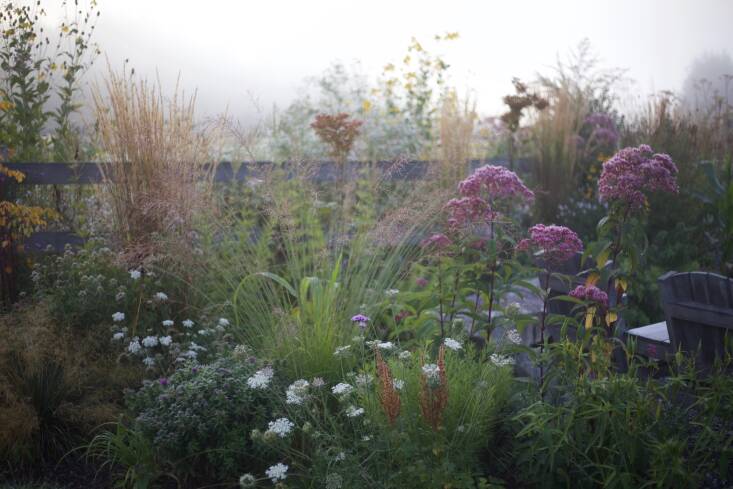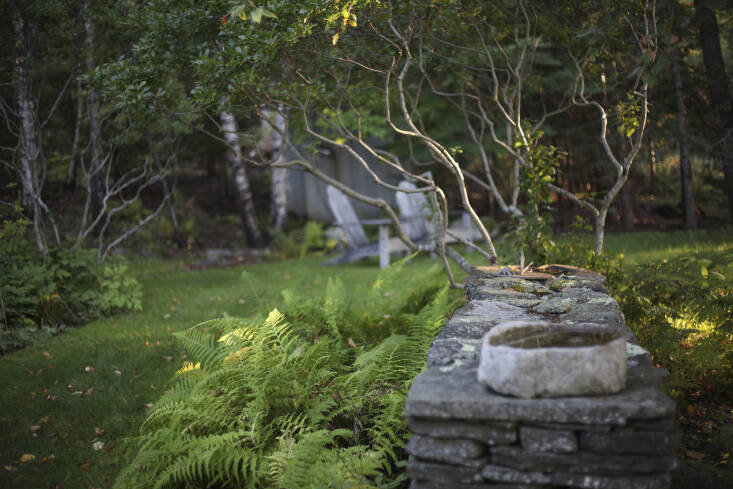Spending the summer in New England for the first time since moving away as a child, I have been struck by an extreme contrast in gardens: those that look on “old England” as the ideal, and another sort, which are seriously exciting. The latter don’t bother with neat mounds of clipped boxwood and straight paths, thrown like a grid over the landscape; instead they are more naturally in tune with the spirit of the place—as it is today—informed by layers of cultural history that stretch back much further than the colonists, while moving forward into the 21st century.
Creating a sense of place is the opposite of applying conventional wisdom; it has to do with immersion and a willingness to look and think. Caleb Davis of Songscape Gardens in Bar Harbor, Maine, works closely within his very particular location, drawing on a background in agro-ecology and stonework for his horticultural design focus. “This part of Maine has its unique attributes, which have a big role in how I’ve learned to use plants,” he explains. “The combination of the ecology and culture of the region is so central to how I approach my work that it would be challenging to take it and superimpose it somewhere else.”
It’s August—let’s visit Maine:
Photography by Caleb Davis.

Caleb’s gardens have the effect of merging into the wilderness, with minimal intervention. “My ideal inhabited landscape does have plenty of gardening, but with more emphasis on the beauty found in process,” he says. “Gardening that is less about the finished product and more about the growing—of plants, communities of organisms, and ourselves.” Referencing the agricultural philosopher Masanobu Fukuoka, he continues: “We are often at more risk of doing too much than too little. I think there is a lot of truth to that in horticulture.”




“A big part of why I love stone work is because that is the one thing that people can enjoy, year round. People think of stone as a static element but when you have it in your landscape you start to realize that it’s dynamic in how it responds to weather. It’s fun to see the subtlety of changes throughout the seasons and as it ages. Seeing the rain and snow and frost interact with the stone is a really beautiful part of our winter landscape.”

Caleb does not adhere to the “Sisyphus endeavor” of forcing a design vision on to a place, that only works for the short window when summer people are in residence. “Our growing season is so short. It’s another reason why trying to superimpose more classical horticultural visions on to the landscape is really hard. It’s just such a unique place.”

Caleb has planted robust, competitive garden cultivars such as Rudbeckia laciniata, Coreopsis tripteris, Filipendula rubra ‘Venusta’, and Eupatorium maculatum ‘Gateway’ beyond this garden’s perimeter, putting them straight into the surrounding vegetation, without doing a lot of digging. Newly unearthed soil is a magnet for weeds, and the permaculture method known as ‘chop and drop’ is useful here: “Instead of pulling out weeds that are competing with the plants you’re growing, you’re cutting them at their base and leaving the herbaceous material right there, as mulch. It’s a way of nudging back wild species; creating a bit of space for your planting and using it as a mulch in place.”

Caleb and his team like to mix granite with field stone, the irregular shaped rock associated with farm walls throughout New England. “It’s glacial till, a mix of types of stones, and a range of colours and shapes.” The above wall is a typical Songscape endeavor, a mix of field stone and blockier granite pieces. “When you use the dry stacked field stone with granite, there’s an informality—but it also adds a nice formal structure,” says Caleb. Informally formal is as formal as it gets.
For more on Maine, see:
- May in Maine: Heaven on Earth?
- Before and After: Big Box Meets Local for a $550 Porch Makeover in Portland, Maine
- Landscape Architect Visit: Clamshell Alley on the Coast of Maine
For more on our new book on Maine design:








Have a Question or Comment About This Post?
Join the conversation